Chemical reactions are fundamental to understanding the natural world and human innovations. They involve transformations of matter‚ forming the basis of chemistry. This section introduces key concepts‚ processes‚ and the importance of studying reactions‚ providing a foundation for advanced topics like stoichiometry and redox reactions.
1.1 Importance of Studying Chemical Reactions
Studying chemical reactions is crucial for understanding how matter transforms and energy is exchanged. It underpins advancements in medicine‚ energy‚ and environmental science‚ enabling the development of new materials and technologies. By mastering chemical reactions‚ scientists can predict outcomes‚ optimize processes‚ and address global challenges. This knowledge also provides a foundation for understanding complex phenomena in fields like biochemistry and engineering‚ making it essential for both academic and practical applications.
1.2 Key Concepts in Chemical Reactions
Key concepts in chemical reactions include reactants‚ products‚ and the chemical equation‚ which represents the reaction. Understanding these elements is vital for analyzing and predicting outcomes. Reactants are substances consumed‚ while products are formed. Chemical equations use symbols and formulas to depict transformations. Balancing equations ensures mass conservation‚ a fundamental principle. Additionally‚ reaction types‚ stoichiometry‚ and the role of catalysts are essential concepts that form the core of chemical reaction studies‚ providing a framework for deeper exploration.
1.3 Components of a Chemical Equation
A chemical equation consists of reactants‚ products‚ and arrows indicating direction. Reactants are on the left‚ products on the right. Chemical formulas represent substances‚ and coefficients balance atom counts. Symbols like (s)‚ (l)‚ (g)‚ and (aq) denote states. Catalysts and conditions may be written above or below arrows. The equation’s components collectively illustrate the reaction’s process‚ ensuring clarity and precision in chemical communication and analysis.
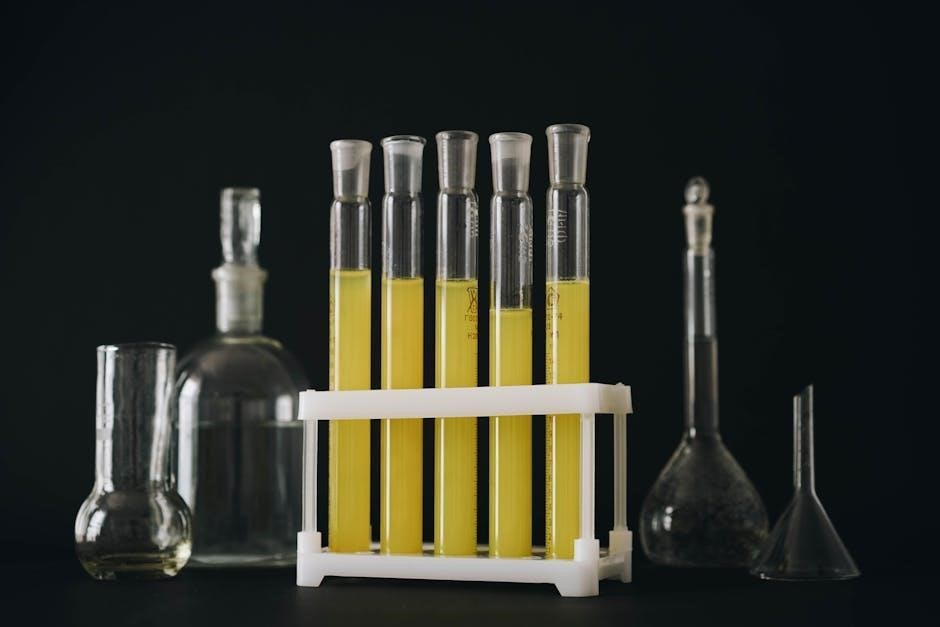
Types of Chemical Reactions
Chemical reactions are categorized into synthesis‚ decomposition‚ combustion‚ and single/double replacement reactions. Each type follows distinct patterns‚ guiding the transformation of reactants into products.
2.1 Synthesis Reactions
Synthesis reactions involve the combination of two or more reactants to form a single product. They are also known as combination reactions. For example‚ hydrogen gas reacting with oxygen to form water is a synthesis reaction. These reactions are fundamental in chemistry‚ illustrating how elements or compounds merge to create new substances. Understanding synthesis reactions is crucial for grasping chemical bonding and the formation of complex molecules from simpler ones.
2.2 Decomposition Reactions
Decomposition reactions involve the breakdown of a single compound into two or more simpler substances. These reactions are the reverse of synthesis reactions. A common example is the decomposition of hydrogen peroxide into water and oxygen. Decomposition reactions often require energy input‚ such as heat or light‚ to initiate. They are essential in understanding chemical stability and the separation of compounds into their constituent elements or simpler molecules.
2.3 Combustion Reactions
Combustion reactions involve the reaction of a substance with oxygen‚ typically producing heat and light. These reactions are exothermic and often involve fuels like hydrocarbons. A general form is: fuel + oxygen → carbon dioxide + water + heat. For example‚ methane burns to produce CO₂ and H₂O. Combustion is crucial in industrial processes and everyday applications‚ such as heating and cooking‚ making it a fundamental reaction type in chemistry.
2.4 Single Replacement Reactions
Single replacement reactions involve one element displacing another in a compound. The general form is: A + BC → AC + B. For example‚ zinc reacting with hydrochloric acid produces zinc chloride and hydrogen gas. These reactions often involve metals and acids or halogens. They demonstrate the reactivity of elements‚ with more reactive elements replacing less reactive ones‚ making them key in understanding reactivity series and chemical reactivity principles.
2.5 Double Replacement Reactions
Double replacement reactions occur when two compounds exchange ions to form two new compounds. The general form is AB + CD → AD + CB. For example‚ sodium sulfate reacts with barium chloride to form barium sulfate (a precipitate) and sodium chloride. These reactions often result in the formation of a precipitate‚ gas‚ or water‚ making them identifiable by such changes. They are commonly used in laboratory settings to produce specific products or to remove impurities from solutions.
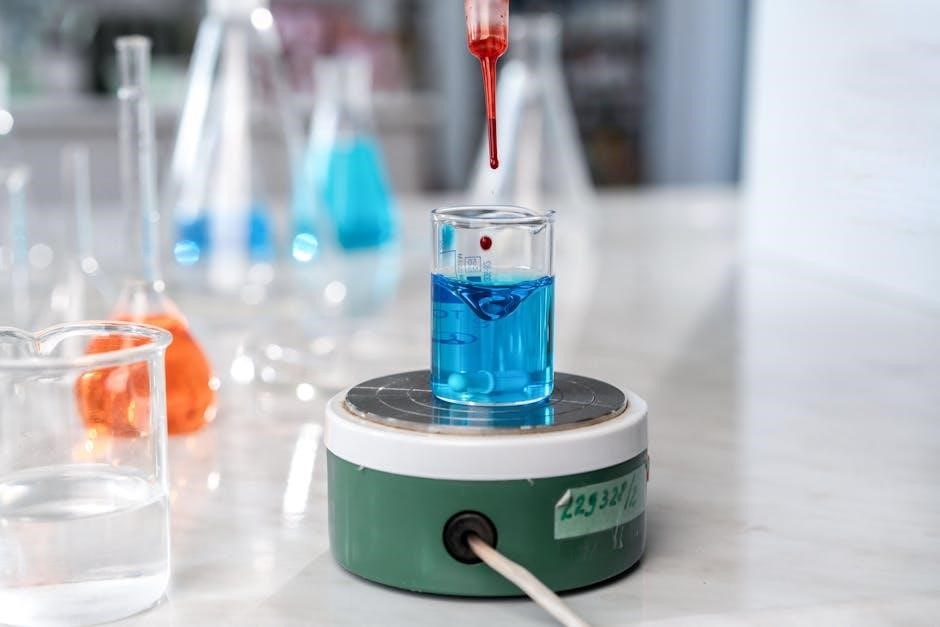
Writing and Balancing Chemical Equations
Mastering the steps to write and balance chemical equations is essential for understanding reaction stoichiometry. This section outlines the process of identifying reactants‚ products‚ and balancing coefficients to ensure mass conservation in reactions.
3.1 Steps to Write a Chemical Equation
Writing a chemical equation involves identifying reactants and products‚ writing their correct chemical formulas‚ and indicating their states of matter. Start by describing the reaction in words‚ then translate it into symbols. Ensure diatomic elements like O₂ and H₂ are correctly represented. Balance the equation by adjusting coefficients to maintain equal atoms of each element on both sides. Use arrows to show the direction of the reaction and include necessary conditions or catalysts for clarity and accuracy in representation.
3.2 Balancing Chemical Equations
Balancing chemical equations ensures the law of conservation of mass is upheld. Start by counting atoms of each element on both sides. Add coefficients to balance one element at a time‚ typically beginning with elements that appear only once. Adjust coefficients systematically to achieve equality. Polyatomic ions should be treated as single units. Once balanced‚ verify that the equation is accurate‚ ensuring the same number of atoms for each element on both sides‚ reflecting a valid chemical reaction.
3.3 Importance of Balancing Equations
Balancing chemical equations is essential for upholding the law of conservation of mass. It ensures that the number of atoms of each element is equal on both sides. This process is critical for stoichiometry‚ allowing accurate calculations of mole ratios‚ theoretical yields‚ and reaction rates. Balanced equations are fundamental for predicting reaction outcomes‚ designing experiments‚ and understanding reaction mechanisms. They also form the basis for practical applications in chemistry‚ such as industrial manufacturing and laboratory experiments‚ making them indispensable in both theoretical and applied chemistry.

Stoichiometry in Chemical Reactions
Stoichiometry in chemical reactions involves mole ratios‚ limiting reactants‚ and percent yield calculations. It quantifies reactants and products‚ essential for theoretical yields and reaction efficiency.
4.1 Mole Ratios in Reactions
Mole ratios in chemical reactions are derived from balanced equations‚ showing the proportional relationship between reactants and products. These ratios guide stoichiometric calculations‚ determining the amount of substances involved. By understanding mole ratios‚ chemists can predict the theoretical yield of a reaction‚ identify limiting reactants‚ and calculate the required quantities of reactants for desired products. Accurate mole ratio calculations are crucial for efficient and precise chemical processes across various applications.
4.2 Limiting and Excess Reactants
The limiting reactant determines the maximum amount of product in a reaction‚ while excess reactants remain unreacted. Identifying the limiting reactant involves comparing mole ratios of reactants to the balanced equation. Calculations often use stoichiometric ratios to determine which reactant is consumed first. Understanding this concept is essential for optimizing reactions‚ minimizing waste‚ and achieving desired product quantities in both laboratory and industrial settings. Accurate identification ensures efficient use of resources and precise control over reaction outcomes.
4.3 Percent Yield and Theoretical Yield
Theoretical yield is the maximum amount of product predicted by stoichiometry‚ assuming 100% efficiency. Percent yield is the actual yield compared to the theoretical‚ expressed as a percentage. Calculating these involves balancing equations‚ mole ratios‚ and experimental data. Percent yield identifies how efficient a reaction is‚ while theoretical yield provides a baseline for comparison. These concepts are crucial for assessing reaction performance‚ optimizing conditions‚ and understanding losses in experiments. They bridge theoretical predictions with practical results in chemical synthesis and analysis.

Net Ionic Equations
Net ionic equations simplify chemical reactions by showing only the species that change‚ excluding spectator ions. They clarify reaction mechanisms and focus on essential transformations.
5;1 Understanding Net Ionic Equations
Net ionic equations focus on the species directly involved in a chemical reaction‚ excluding spectator ions. They provide a clear‚ simplified representation of the reaction mechanism. By identifying and removing spectator ions‚ which remain unchanged‚ net ionic equations highlight the essential transformations. This approach is crucial for analyzing reaction stoichiometry‚ understanding redox processes‚ and visualizing aqueous reactions. Mastering net ionic equations enhances the ability to predict and explain reaction outcomes effectively.
5.2 Writing Net Ionic Equations
Writing net ionic equations involves identifying the species that change during a reaction. First‚ separate aqueous compounds into ions and keep solids‚ liquids‚ and gases intact. Next‚ eliminate spectator ions‚ which appear unchanged on both sides. Finally‚ ensure the equation is balanced. For example‚ the reaction between NaOH and HCl in water produces NaCl and H₂O. The net ionic equation is H⁺(aq) + OH⁻(aq) → H₂O(l)‚ highlighting only the species that react.
5.3 Spectator Ions in Net Ionic Equations
Spectator ions are ions that appear unchanged in both the reactant and product sides of a chemical equation. They do not participate in the reaction and are typically aqueous. When writing net ionic equations‚ spectator ions are omitted. For example‚ in the reaction between Na₂SO₄ and BaCl₂‚ the net ionic equation is SO₄²⁻(aq) + Ba²⁺(aq) → BaSO₄(s). The Na⁺ and Cl⁻ ions are spectators and are excluded from the final equation.

Acid-Base Reactions
Acid-base reactions involve the transfer of protons‚ producing water and a salt. They are key in chemistry‚ driving neutralization processes and shaping solution chemistry behavior.
6.1 Characteristics of Acid-Base Reactions
Acid-base reactions involve the transfer of protons (H⁺ ions) from acids to bases‚ forming water and a salt. These reactions are exothermic and result in neutralization. Acids donate H⁺‚ while bases accept them‚ leading to the formation of ions in solution. A key feature is the production of water‚ a universal indicator of acid-base chemistry. Examples include reactions between strong acids (e.g.‚ HCl) and strong bases (e.g.‚ NaOH)‚ yielding a neutral salt and water.
6.2 Examples of Acid-Base Reactions
Acid-base reactions are common and essential in chemistry. A classic example is the reaction between hydrochloric acid (HCl) and sodium hydroxide (NaOH)‚ producing sodium chloride (NaCl) and water (H₂O). Another example is sulfuric acid (H₂SO₄) reacting with potassium hydroxide (KOH)‚ yielding potassium sulfate (K₂SO₄) and water. These reactions demonstrate the neutralization process‚ where acids and bases combine to form salts and water‚ a hallmark of acid-base chemistry.
6.3 Neutralization Reactions
Neutralization reactions occur when acids and bases react to form salts and water. In these reactions‚ the H⁺ ions from acids combine with OH⁻ ions from bases to produce H₂O. For example‚ sulfuric acid (H₂SO₄) reacting with sodium hydroxide (NaOH) forms sodium sulfate (Na₂SO₄) and water. These reactions are exothermic and often used in laboratories to neutralize excess acids or bases. Neutralization is a fundamental process in chemistry‚ illustrating acid-base interactions and their practical applications.
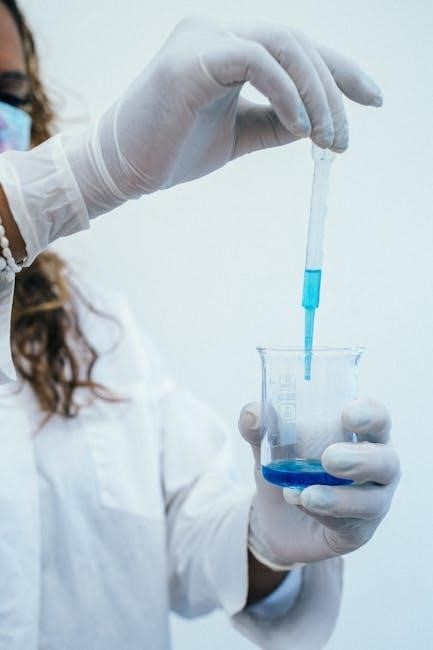
Redox Reactions
Redox reactions involve the transfer of electrons between species‚ causing oxidation (loss of electrons) and reduction (gain of electrons). These processes are crucial in chemical transformations‚ energy storage‚ and biological systems‚ enabling understanding of reaction mechanisms and their practical applications.
7.1 Oxidation and Reduction
Oxidation and reduction are fundamental processes in redox reactions‚ involving the transfer of electrons. Oxidation refers to the loss of electrons‚ while reduction is the gain. These processes often occur together‚ driving chemical changes in reactions like combustion and rusting. Oxidizing agents facilitate oxidation by accepting electrons‚ while reducing agents donate electrons‚ promoting reduction. Understanding these concepts is essential for analyzing energy storage in batteries‚ respiration in living organisms‚ and industrial processes.
7.2 Balancing Redox Reactions
Balancing redox reactions involves separating the reaction into oxidation and reduction half-reactions. Each half-reaction is balanced for atoms and charge‚ ensuring electron transfer is consistent. Steps include identifying oxidation states‚ splitting into half-reactions‚ balancing elements‚ and equalizing electrons. Combining the half-reactions gives the overall balanced equation. This method is crucial for reactions in acidic or basic solutions‚ ensuring accuracy in stoichiometric calculations and understanding reaction mechanisms. Mastery of this skill is essential for advanced chemistry topics and real-world applications.
7;3 Identifying Oxidizing and Reducing Agents
Oxidizing agents are substances that cause oxidation by gaining electrons‚ while reducing agents undergo reduction by losing electrons. Identifying them involves analyzing oxidation states in a reaction. Oxidizing agents are typically species that are reduced‚ and reducing agents are those that are oxidized. Common oxidizing agents include oxygen and chlorine‚ while reducing agents often involve hydrogen or metals. Recognizing these roles is critical for understanding and balancing redox reactions‚ as well as predicting reaction outcomes in various chemical processes and applications;
Evidence of Chemical Reactions
Chemical reactions are often confirmed by observable changes: color changes‚ gas bubbles‚ precipitate formation‚ or physical transformations. These signs indicate chemical processes have occurred‚ altering substances chemically.
8.1 Physical Changes as Evidence
Physical changes‚ such as changes in color‚ state‚ or texture‚ often indicate a chemical reaction. For example‚ melting ice changes state but isn’t a reaction‚ while burning wood transforms into ash‚ soot‚ and carbon dioxide. Physical changes alone aren’t always conclusive signs of a reaction‚ but when combined with other evidence‚ like odor or sound‚ they provide strong indicators of chemical activity. Observing these changes helps identify reactions in various chemical processes.
8.2 Gas Evolution as Evidence
Gas evolution is a clear sign of a chemical reaction‚ often producing visible bubbles or a hissing sound. For example‚ reactions between acids and carbonates release carbon dioxide‚ while metals reacting with acids produce hydrogen gas. These gases can be identified using tests‚ such as limewater turning milky for CO2 or burning hydrogen to produce a popping sound. Gas formation provides direct evidence of chemical changes‚ making it a reliable indicator of a reaction’s occurrence and helping to identify the products formed.
8.3 Precipitate Formation as Evidence
Precipitate formation is a visible indicator of a chemical reaction‚ where an insoluble solid forms from a solution. This occurs when the product of a reaction has low solubility. For example‚ mixing sodium sulfate and barium chloride solutions produces a white barium sulfate precipitate. The appearance of a precipitate confirms a reaction has occurred‚ as it involves the formation of new substances with distinct properties. This physical change is a key evidence used to identify and study chemical reactions in various laboratory settings.
8.4 Color Changes as Evidence
Color changes are a striking indication of chemical reactions. They occur when a reactant or product has distinct pigmentation. For instance‚ the reaction between hydrogen peroxide and potassium permanganate produces a color shift from purple to green. Such changes are often due to the formation of new compounds with specific light-absorbing properties. This visual evidence is widely used in titrations and redox reactions to signal the endpoint or completion of a reaction‚ making it a valuable tool for monitoring chemical processes in both laboratory and industrial settings.
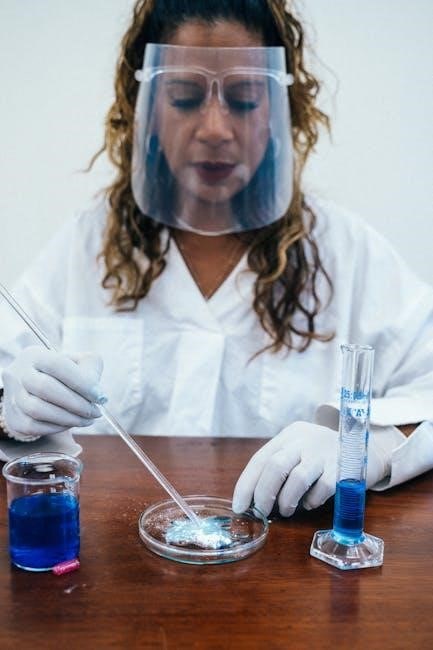
Titrations in Chemical Reactions
Titrations are precise methods for determining concentrations of solutions. They involve reacting known concentrations of acids or bases with unknown solutions. Essential in stoichiometry and chemical analysis.
9.1 Types of Titrations
Titrations are classified into several types based on the reacting species. Acid-base titrations involve acids and bases‚ while redox titrations involve oxidation-reduction reactions. Precipitation titrations form insoluble salts‚ and complexometric titrations involve chelating agents like EDTA. Each type requires specific indicators to signal the endpoint. Understanding these distinctions is crucial for accurate chemical analysis and stoichiometric calculations. Proper selection of titration type ensures precise determination of unknown concentrations in laboratory settings.
9.2 Calculations in Titration
Titration calculations involve determining unknown concentrations using stoichiometric relationships. Mole ratios from balanced equations guide the conversion of volumes and concentrations. Accuracy in measuring volumes and understanding reaction stoichiometry is critical. Key calculations include determining unknown concentrations‚ percent purity‚ or the pH at equivalence points. These computations rely on precise data from titration curves and indicators‚ ensuring reliable results in quantitative chemical analysis.
9.3 Applications of Titrations
Titrations are widely used in quality control‚ environmental testing‚ and medical diagnostics to determine concentrations of substances. They are essential for analyzing the purity of chemicals‚ testing water quality‚ and measuring drug concentrations in pharmaceuticals. In food industries‚ titrations ensure safety by detecting additives and contaminants. Academic research relies on titrations for precise measurements‚ while industrial processes use them to optimize reactions. Their versatility and accuracy make titrations indispensable in both routine and advanced chemical analyses‚ ensuring precision and reliability across diverse applications.
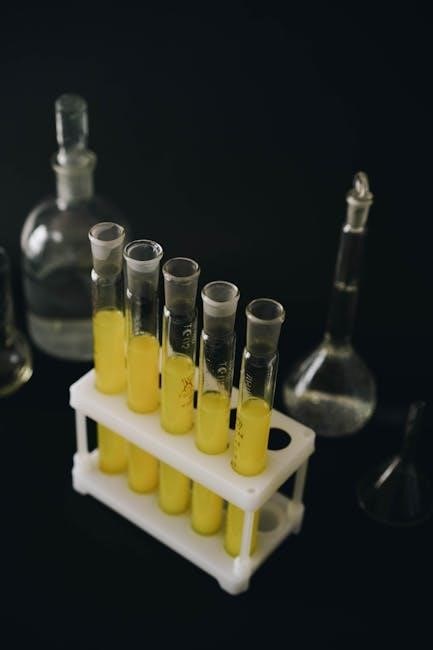
Reaction Rates and Factors Affecting Them
Reaction rates measure the speed of chemical transformations. Factors like concentration‚ temperature‚ catalysts‚ and surface area significantly influence reaction rates‚ optimizing processes in industries and labs.
10.1 Understanding Reaction Rates
Reaction rates measure the speed at which reactants convert into products. They are influenced by factors such as concentration‚ temperature‚ surface area‚ and catalysts. Higher concentration or temperature typically increases the rate‚ while catalysts speed up reactions without being consumed. Understanding reaction rates is crucial for controlling chemical processes in both laboratory settings and industrial applications‚ ensuring efficiency and safety. Accurate rate measurements help predict and optimize reaction outcomes.
10.2 Factors Affecting Reaction Rates
Reaction rates are influenced by several key factors‚ including concentration‚ temperature‚ surface area‚ and catalysts. Increasing concentration or temperature typically accelerates reactions‚ as particles collide more frequently and energetically. A larger surface area‚ such as breaking solids into smaller pieces‚ also speeds up reactions by exposing more reactant particles. Catalysts lower activation energy‚ enabling reactions to proceed faster without being consumed. These factors are critical in controlling and optimizing reaction rates in various chemical processes.
10.3 Catalysts and Their Role
Catalysts are substances that accelerate chemical reactions without being consumed in the process. They work by lowering the activation energy required for the reaction to occur‚ making it proceed faster. Catalysts are essential in industrial processes‚ as they enhance efficiency and reduce costs. They are also used in biological systems‚ where enzymes act as natural catalysts. Without catalysts‚ many reactions would be too slow or impractical to perform‚ making them indispensable in both laboratory and real-world applications to achieve desired outcomes efficiently and sustainably.
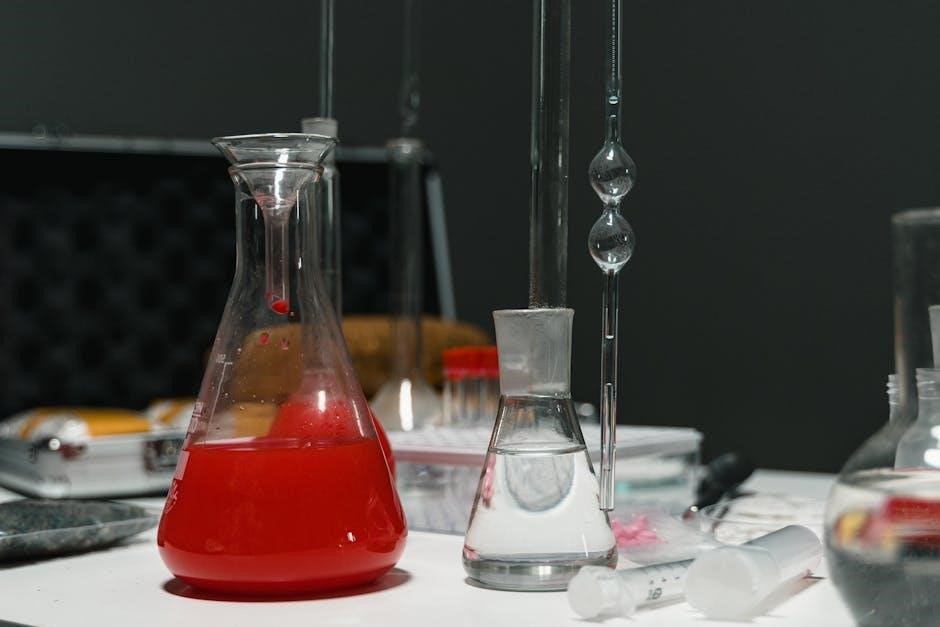
Practice Problems and Solutions
This section provides comprehensive practice problems covering various chemical reactions‚ stoichiometry‚ and balancing equations‚ with detailed solutions to enhance understanding and mastery of key concepts effectively.
11.1 Balancing Chemical Equations Practice
Mastering the skill of balancing chemical equations is essential for understanding chemical reactions. Practice problems include scenarios like the decomposition of potassium chlorate into potassium chloride and oxygen gas. Students are guided to balance equations step-by-step‚ ensuring the number of atoms of each element is equal on both sides. Special attention is given to diatomic elements and ions. Each problem reinforces the importance of precise coefficients and correct states of matter‚ preparing learners for more complex stoichiometric calculations and reaction analysis.
11.2 Stoichiometry Practice Problems
Stoichiometry practice problems focus on mole ratios‚ limiting reactants‚ and percent yield calculations. Exercises involve determining the theoretical yield of products‚ such as oxygen from potassium chlorate decomposition‚ and calculating the actual yield based on experimental data. Problems also explore identifying the limiting reactant in reactions like aluminum and iodine forming aluminum iodide. These exercises emphasize precise calculations and real-world applications‚ helping students grasp the quantitative aspects of chemical reactions and their practical implications in laboratory and industrial settings.
11.3 Identifying Types of Reactions
Practice problems focus on classifying reactions into synthesis‚ decomposition‚ combustion‚ single or double replacement‚ and acid-base types. Students analyze reaction descriptions and equations to determine the reaction type. For example‚ identifying if a reaction involves the combination of elements or the exchange of ions. Exercises include questions like categorizing the decomposition of potassium chlorate or the reaction of aluminum with iodine. These problems enhance understanding of reaction mechanisms and their classification‚ essential for predicting and writing chemical equations accurately.



About the author